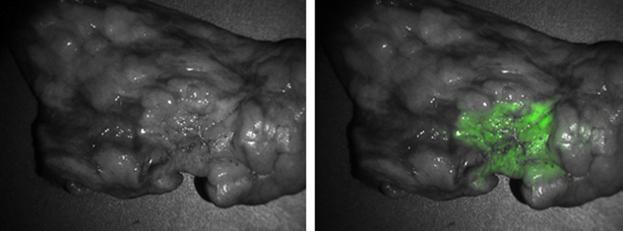Real-time imaging of lung lesions during surgery helps localize tumors and improve precision

Intraoperative imaging detects a lung adenocarcinoma during a pulmonary resection. Credit: The Journal of Thoracic and Cardiovascular Surgery
Summary: New molecular tools are emerging to identify lung adenocarcinomas during pulmonary resection. The results of a proof-of-concept study suggest that lung cancer fluorescent imaging during surgery using targeted molecular agents may soon be a reality. While the methodology still needs refinement, the technique holds the possibility of precise visualization of tumor margins, detection of other tumors or metastases, localization of small malignant ground glass opacities, and accurate identification of lymph nodes containing metastatic cancer cells.
Beverly, MA, July 29, 2015 – More than 80,000 people undergo resection of a pulmonary tumor each year, and currently the only method to determine if the tumor is malignant is histologic analysis. A new study reports that a targeted molecular contrast agent can be used successfully to cause lung adenocarcinomas to fluoresce during pulmonary surgery. This enables real-time optical imaging during surgery and the identification of cancer cells. The results are reported in The Journal of Thoracic and Cardiovascular Surgery, the official publication of the American Association for Thoracic Surgery (AATS).
“This approach may allow surgeons to perform resections with confidence that the entire tumor burden has been eliminated. In the future, with improved devices and molecular contrast agents, this approach may reduce the local recurrence rate and improve intraoperative identification of metastatic cancer cells,” explained lead investigator Sunil Singhal, MD, of the Department of Surgery, University of Pennsylvania Perelman School of Medicine (Philadelphia).
In this proof-of-concept study, 50 patients (ages 25-85 years) with diagnosed adenocarcinoma received 0.1 mg/kg of a fluorescent folate receptor alpha (FRα)-targeted molecular contrast agent (On Target Laboratories) four hours before surgery. This agent binds to folate receptor α, a protein found on the surface of most lung adenocarcinoma cells. This resulted in fluorescence of 92% of pulmonary adenocarcinomas, allowing surgeons to visually identify tumor cells during surgery.
Upon opening the chest cavity, the primary lesion was located using traditional methods of visual inspection and manual palpation. The cancer was imaged and photo-documented with a specialized imaging system [Artemis Fluorescence Imaging System (Quest Medical Imaging) and the FloCam system (developed in their laboratory)].
In seven of the 50 cases (14%), the tumor could easily be identified by its fluorescence. The tumors ranged in size from 1.1 to 8.0 cm, but size did not influence fluorescence. All of these tumors were within 1.2 cm of the lung surface.
Of the remaining 43 tumors, 39 appeared fluorescent after the overlying tissue was opened and the tumor exposed. The fluorescence was uniform across the tumor's surface, and the demarcation between tumor and normal surrounding tissue was clearly visible. On average, the optical imaging was quick, ranging from five to 15 minutes.
The technique proved to be particularly helpful in two cases. In a 50-year old man thought to have a 2.1 cm primary lung adenocarcinoma in the right upper pulmonary lobe, molecular imaging of the excised lobe identified a second pulmonary nodule that was fluorescent, leading to re-staging of the patient. In another patient, who was thought to have no evidence of metastatic disease, molecular imaging showed evidence of cancer elsewhere.
Four tumors (8%) did not exhibit fluorescence, and further analysis showed that these tumors did not express FRα antigens to allow localization of the contrast agent to the tumor. Thus, the FRα imaging agent is not useful for all lung adenocarcinomas.
“This technology is safe,” stated Dr. Singhal. “The use of a visible-wavelength fluorophore avoids ionizing radiation and confers no risk to the patient, surgeon, or operating room personnel. In our experience, only one patient had a mild allergic reaction to the contrast agent that was easily managed with diphenhydramine. With miniaturization of imaging devices, this method will be particularly useful in minimally invasive surgery, such as VATS and robotic surgery.”
“What Okusanya and colleagues have discovered is that they can make 92% of all adenocarcinomas glow to the naked eye, requiring no special training at all,” noted Michael I. Ebright, MD, of the Section of Thoracic Surgery, New York-Presbyterian/Columbia University Medical Center (New York) in an accompanying editorial. “The Achilles' heel of the technique is tumor depth beneath the pleural surface,” as fluorescence was not detectable to the operating surgeon in tumors buried within the lung. However, he added that “this study should be viewed as a launching pad rather than be judged solely on practicality in its current form.” Dr. Ebright looks forward to modification of the system so that it can be used in minimally invasive surgery.
Lung cancer is the leading cause of cancer deaths, with approximately 221,200 deaths due to lung cancer anticipated in 2015. About 85% of lung cancers are non-small cell lung cancers (NSCLC), and adenocarcinoma of the lung is one of the most common forms of NSCLC, in both smokers and nonsmokers.
Media Contact
All latest news from the category: Health and Medicine
This subject area encompasses research and studies in the field of human medicine.
Among the wide-ranging list of topics covered here are anesthesiology, anatomy, surgery, human genetics, hygiene and environmental medicine, internal medicine, neurology, pharmacology, physiology, urology and dental medicine.
Newest articles

High-energy-density aqueous battery based on halogen multi-electron transfer
Traditional non-aqueous lithium-ion batteries have a high energy density, but their safety is compromised due to the flammable organic electrolytes they utilize. Aqueous batteries use water as the solvent for…

First-ever combined heart pump and pig kidney transplant
…gives new hope to patient with terminal illness. Surgeons at NYU Langone Health performed the first-ever combined mechanical heart pump and gene-edited pig kidney transplant surgery in a 54-year-old woman…

Biophysics: Testing how well biomarkers work
LMU researchers have developed a method to determine how reliably target proteins can be labeled using super-resolution fluorescence microscopy. Modern microscopy techniques make it possible to examine the inner workings…





















